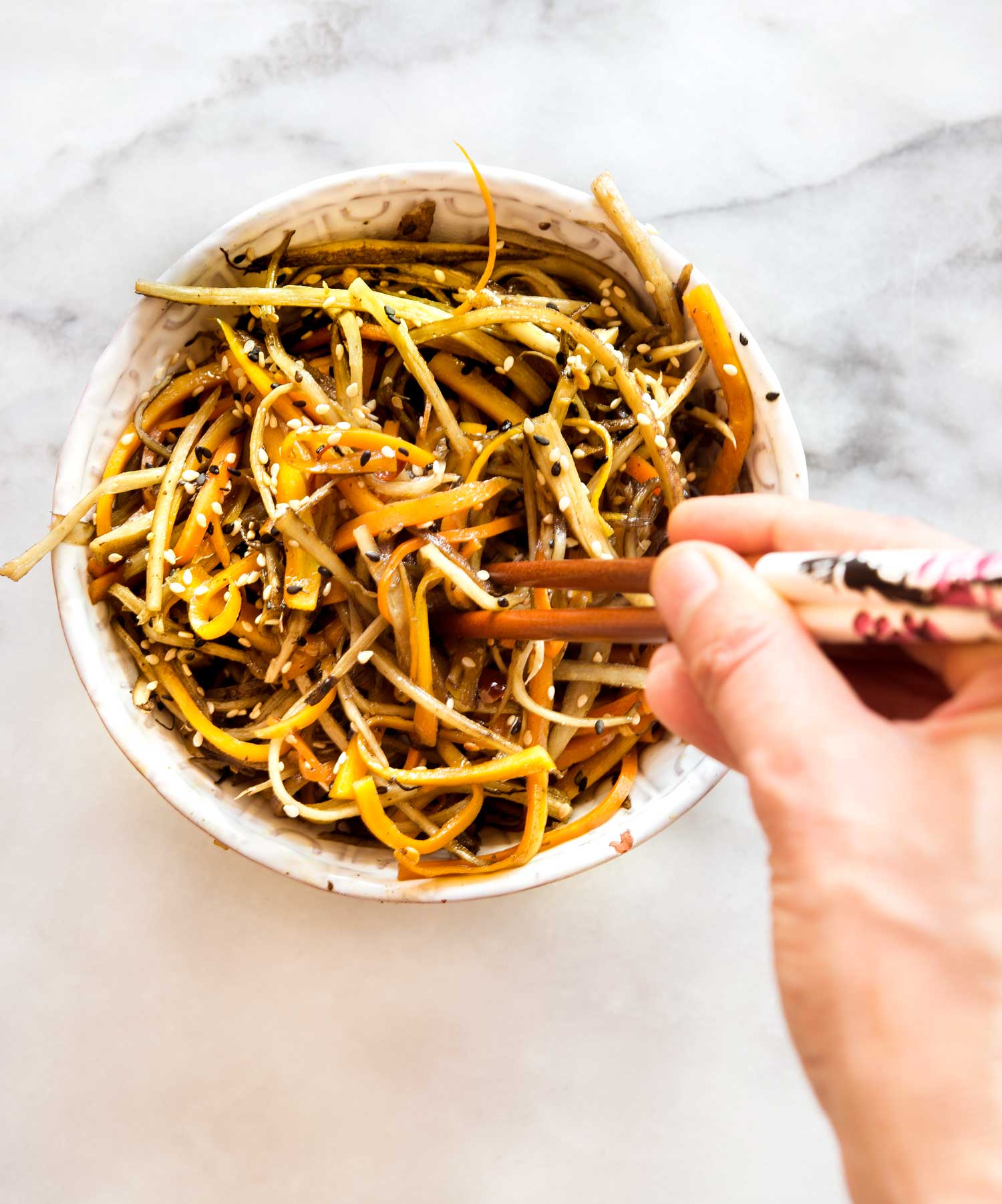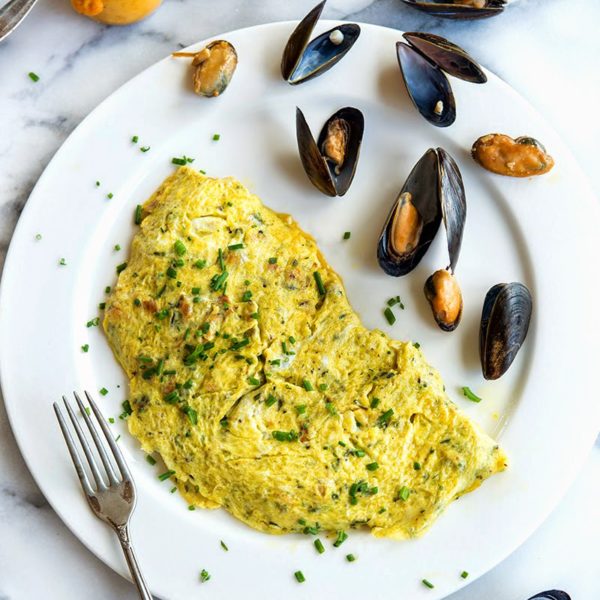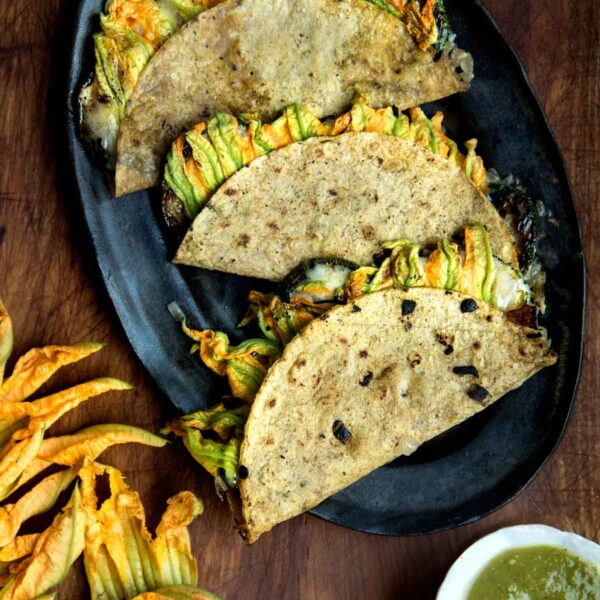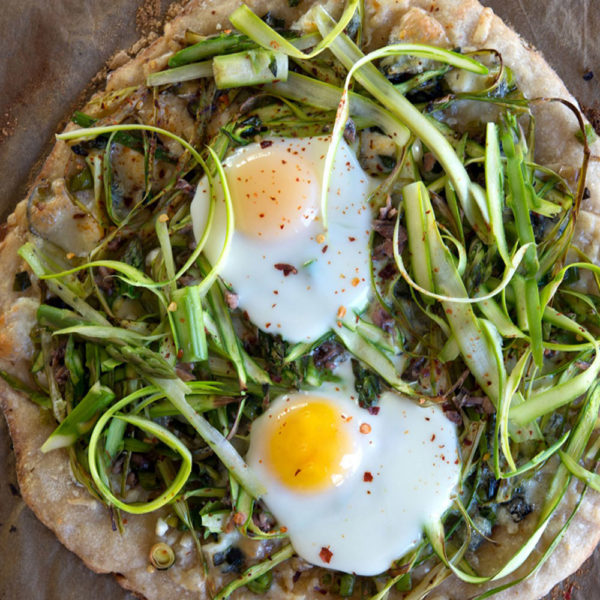This is a simple little salad that I was turned on to a few weeks ago at a Japanese restaurant in Brooklyn, NY. By looks alone, it — kinpira gobo (braised burdock root) — might not seem all that impressive. However, there’s more to this salad than meets the eye. Let your taste buds be the judge. This salad has a lot going on flavor-wise (salty, sweet) and texture-wise (slightly crunchy).
One of my goal’s with this blog is to introduce people to ingredients that might otherwise be overlooked simply due to unfamiliarity. Someone introduced burdock to me; hence, I wish to introduce it to you. So be brave. Try something new. Life is all about new experiences.
Kinpira gobo or braised burdock root salad…
The burdock (along with carrot) is julienned, stir-fried until softened, and then simmered in a dashi broth with soy sauce, mirin, sake, and small amount of sugar. I added a dried red chile for a bit of heat and finished the salad with a dash of sesame oil and toasted sesame seeds.
I find burdock at various farmers’ markets (Whole Foods too). Check Asian markets as well.
Some interesting tidbits about burdock…
Burdock is in the Asteraceae family (aka aster, daisy, or sunflower family), which is comprised of more than 1620 genera and 23,600 species of herbs, shrubs, and trees. Members of the Asteraceae family include artichokes, dandelions, endive, salsify, sunflower, thistle, and wormwood (the source of the oil used in absinthe).
Burdock has been used for thousands of years in Chinese medicine, primarily for its blood cleansing and skin healing properties.
Burdock has been shown to possess strong antioxidant activity and to have prebiotic properties that can improve health (and maintain a healthy digestive system).
The twiggy looking root pictured below is burdock.
Along with burdock, I julienned a bit of carrot for this salad…
Burdock oxidizes quickly. To prevent browning, have a bowl of acidulated water (water + lemon juice) ready.
This is my favorite gadget for julienning vegetables.
Blistered shishito; shiitake mushrooms braised in dashi, soy, mirin, and sake; and seasonal vegetables to accompany the burdock salad…

All-purpose dashi…
You’ll need to make a basic dashi stock for the salad. Making dashi is simple and takes but a few minutes.
Ingredients needed: 1) bonito flakes (aka katsuobushi), 2) kombu (seaweed), and 3) water.
In a pinch, you could use instant dashi; look for MSG-free brands.
FYI…
Kombu is a type of sea vegetable, otherwise known as kelp (from the family Laminariaceae). Am not one to harp on the health benefits of food, though I will say that sea vegetables are exceptionally good for you. They provide the broadest range of minerals of any food and contain virtually all the minerals found in the ocean. Kombu has a high concentration of glutamic acid, which provides that umami taste — a briny, almost mushroom-like flavor.
Burdock Root (Gobo) Salad
1 lemon
1 3-foot burdock root 2 large handfuls burdock root, *unpeeled and julienned
1 large carrot,*unpeeled julienned
1/2 cup dashi (recipe to follow)
2 tablespoons mirin
2 tablespoons soy or tamari
1 tablespoon sake
1/2 tablespoon sugar
1 dried chile, sliced
1 tablespoon oil
1/2 teaspoon sesame oil
Toasted sesame seeds
Prepare a bowl of acidulated (lemon) water to prevent burdock from oxidizing. Julienne the burdock and place in the water. Drain.
Combine the dashi, mirin, soy or tamari, sake, sugar, and chile in a bowl. Whisk to combine.
Heat the oil in a skillet over medium-high heat. Add the burdock and carrot, and saute 2-3 minutes. Add the dashi/soy mixture and simmer for 5-7 minutes, until the liquid is evaporated. Remove from the heat and add the sesame oil and toasted sesame seeds.
*Note: No need to peel burdock or carrot. FYI, most of a burdock root’s nutrition is the skin.
All-Purpose Dashi
4 cups of water
1 piece of kombu, about 6-inches long
2 handfuls of (bonito flakes) katsuobushi
Heat the kombu and water in a saucepan over medium heat until it just about boils (you’ll see tiny bubbles along the bottom of the pan). Remove the kombu and bring the liquid to a boil. Drop in the bonito flakes (katsuobushi). Boil for 1 minute, then remove the saucepan from the heat.
Let the bonito flakes (katsuobushi) steep for 5-10 minutes, depending on how potent you want the dashi. The longer you allow the katsuobushi to steep, the stronger the dashi. Strain.












